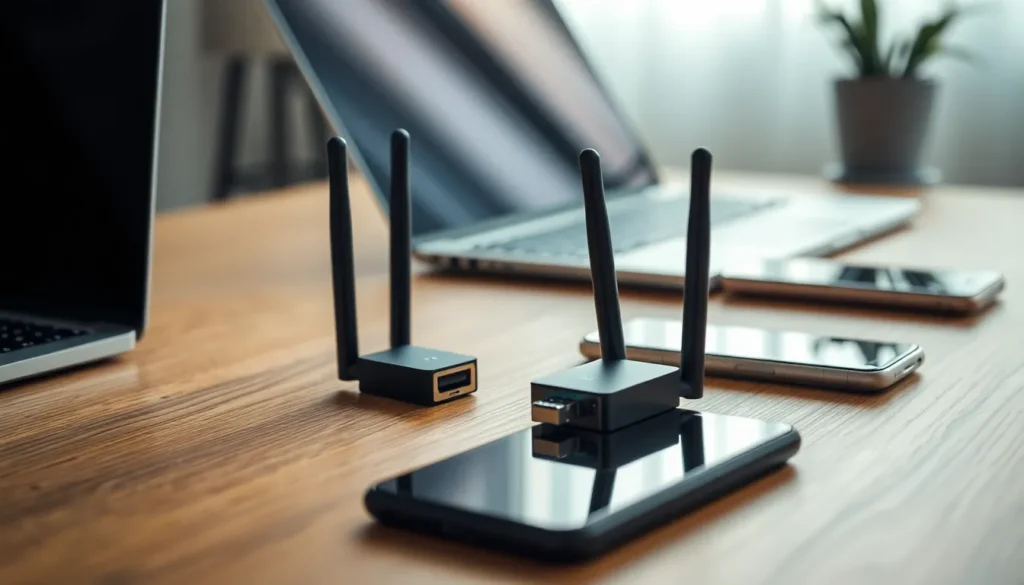In a world where buffering videos and dropped connections can turn a peaceful evening into a tech nightmare, the wireless network adapter is the unsung hero of modern connectivity. Imagine streaming your favorite show without the dreaded “loading” icon or gaming online without lag. Sounds like a dream, right? Well, with the right wireless network adapter, that dream can become a reality.
These nifty devices transform your internet experience from a frustrating crawl to a lightning-fast sprint. Whether you’re working from home or just binge-watching the latest series, a reliable wireless adapter ensures smooth sailing on the information superhighway. So, if you’re tired of your connection playing hide-and-seek, it’s time to explore the world of wireless network adapters and discover how they can elevate your online experience to new heights.
Table of Contents
ToggleOverview of Wireless Network Adapters
Wireless network adapters serve as critical components for achieving reliable internet connections. These devices connect computers, laptops, and gaming consoles to wireless networks, facilitating access to online content and applications. By converting wired signals into wireless signals, network adapters enable users to enjoy high-speed internet without physical constraints.
Different types of wireless network adapters exist, including USB adapters, PCIe cards, and built-in options. USB adapters offer flexibility, allowing users to plug them into available ports easily. PCIe cards, on the other hand, require installation inside the computer, providing stable connections for desktop setups. Built-in adapters frequently come pre-installed in laptops, streamlining the process of connecting to Wi-Fi networks.
Wireless network standards play a vital role in performance. The most common standards include 802.11n, 802.11ac, and the latest 802.11ax, known as Wi-Fi 6. Faster speeds, better range, and improved performance in crowded environments characterize Wi-Fi 6, making it an excellent choice for gamers and streamers.
Choosing a wireless network adapter involves considering several factors. Compatibility with existing routers and devices matters. Users should verify that the adapter’s specifications align with their hardware requirements. Range and signal strength also impact performance, especially in large spaces or those with multiple obstacles.
Setups with dual-band capabilities offer flexibility by supporting both 2.4GHz and 5GHz frequencies. Users can experience less interference and better speeds when connecting to the 5GHz band in crowded areas. Thus, selecting the right wireless network adapter enhances overall performance and transforms online experiences.
Types of Wireless Network Adapters

Wireless network adapters come in various forms, each suited to specific needs and setups. Understanding these types helps in selecting the best option for seamless connectivity.
USB Wireless Network Adapters
USB wireless network adapters plug into USB ports on laptops and desktops. Easy to install, they allow for quick upgrades to connected devices. These adapters are portable, making them ideal for users who frequently switch locations. Furthermore, many models support multiple wireless standards, such as 802.11ac, providing fast speeds and reliable connections. Compact designs make them unobtrusive, and users can find options with external antennas for extended range.
PCIe Wireless Network Adapters
PCIe wireless network adapters install directly onto a computer’s motherboard. Enhanced performance characterizes these internal adapters, as they offer faster speeds and lower latency compared to their USB counterparts. Users with gaming rigs or high-performance machines often prefer them for robust connectivity. These adapters usually feature advanced technologies, including MU-MIMO and beamforming, to optimize signal strength. Installation may require technical knowledge, but this type typically provides superior reliability and speed in dense networking environments.
Key Features to Consider
When selecting a wireless network adapter, understanding key features is essential for optimal connectivity. Focus on attributes that enhance performance and compatibility, ensuring an improved online experience.
Speed and Performance
Speed and performance are crucial for a seamless connection. Choose adapters that support advanced wireless standards like 802.11ac or 802.11ax for higher data transfer rates. Minimal latency is achieved through technologies such as MU-MIMO and beamforming. These features enable multiple devices to connect simultaneously without interference. For users who engage in gaming or high-definition streaming, a wireless adapter with maximum throughput can significantly enhance overall experience.
Range and Coverage
Range and coverage determine how well the adapter connects to the network. Look for devices that offer robust signal strength, especially in larger homes or office spaces. Adapters equipped with external antennas often deliver wider coverage. Dual-band options provide improved performance across both 2.4GHz and 5GHz frequencies, reducing dead zones. Ensuring ample range helps maintain a stable connection for devices positioned farther from the router.
Compatibility
Compatibility with existing devices is vital when choosing a wireless network adapter. Check that the adapter supports the appropriate operating system, whether it’s Windows, macOS, or Linux. Older devices may require adapters that support legacy standards. Some devices may also need dedicated drivers for optimal functionality. Selecting universally compatible options prevents connectivity issues, ensuring all devices benefit from enhanced wireless performance.
Benefits of Using Wireless Network Adapters
Wireless network adapters provide numerous advantages for users seeking improved internet connectivity. Users experience the freedom of movement without being tethered to a wired connection. Such flexibility enables seamless access to online content in various locations, enhancing convenience.
High-speed connectivity characterizes many wireless network adapters. Adapters adhering to advanced standards like 802.11ac or 802.11ax offer impressive data transfer rates, crucial for gaming, streaming, and browsing. Reducing latency directly impacts gaming performance, ensuring a more enjoyable experience.
Expanded coverage is another significant benefit. Many USB adapters feature external antennas to boost signal strength in larger spaces. Enhanced range supports uninterrupted connections, whether in a large home or an office environment.
USB wireless network adapters stand out for their portability, appealing to users who frequently switch setups. Plugging them into a USB port allows instant connectivity, proving advantageous for laptop users and remote workers. Flexibility extends beyond portability; compatibility with various devices ensures widespread usage across computers, gaming consoles, and even smart TVs.
Dual-band capabilities play a vital role in optimizing performance. Using both 2.4GHz and 5GHz frequencies minimizes interference from other devices. Consequently, this feature enhances speeds and reliability, vital aspects for users in crowded networks.
The diversity of wireless network adapters presents solutions for various connectivity needs. Consideration of features like speed, range, and compatibility leads to improved online experiences. Choosing the right adapter transforms frustrating internet issues into efficient, reliable connections.
Choosing the Right Wireless Network Adapter
Selecting the right wireless network adapter requires careful consideration of multiple factors. Compatibility plays a vital role, as users must ensure the adapter works with their operating systems and devices. Performance is another critical aspect; adapters supporting advanced standards like 802.11ac or 802.11ax offer higher data transfer rates and reduced latency.
Range remains significant, particularly for larger homes or office spaces. Many USB adapters come equipped with external antennas, which enhance signal strength and coverage. It’s crucial to evaluate whether dual-band capabilities align with user needs. Adapters that operate on both 2.4GHz and 5GHz channels reduce interference and improve connectivity.
Installation ease matters, especially for users who frequently switch locations. USB wireless network adapters shine in this category, allowing for quick plug-and-play setups. Conversely, PCIe cards, while providing superior performance, require a bit more effort for installation. Users need to assess their technical comfort level when deciding between these options.
Budget influences adapter choice, too. Pricing varies based on features and performance levels, so users should weigh their requirements against their budgets. Reading reviews offers insights into real-world performance and reliability, assisting users in making informed decisions.
Lastly, considering future needs also guides selection. Even if current internet usage seems manageable, investing in a more capable adapter can prepare users for evolving demands. By focusing on these factors, selecting the right wireless network adapter becomes a more straightforward process.
Choosing the right wireless network adapter can significantly enhance internet connectivity and user experience. With various options available like USB adapters and PCIe cards, users can find a solution that fits their needs. Prioritizing features such as speed range and compatibility ensures optimal performance and reliability.
Investing in a quality wireless network adapter not only eliminates frustrating connectivity issues but also opens the door to seamless streaming gaming and browsing. By understanding the unique benefits of each type and the latest wireless standards users can make informed decisions that elevate their online activities. Embracing this technology leads to a more enjoyable and efficient internet experience.








